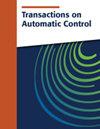McKean-Vlasov型和分支粒子系统近似的离散时间部分可观察随机最优控制问题
IF 7
1区 计算机科学
Q1 AUTOMATION & CONTROL SYSTEMS
引用次数: 0
摘要
本文研究了一类广义的McKean-Vlasov型离散时间部分可观察随机最优控制问题。第一个目标是通过可测量的选择参数来证明动态规划原理(DPP),这为寻找价值函数和最优控制提供了一种方法。在这里,我们采用了Nisio半群技术,这是DPP的内在特征。然后,我们推导了滤波过程的递归公式,使我们能够清楚地跟踪后验分布的时间演变。接下来,我们利用分支粒子系统(分支粒子滤波器)近似后验分布,并说明其收敛性。利用分支粒子系统近似和Bellman方程,设计了一种求解最优控制问题的数值算法。数值实验是本文的最后一部分。本文章由计算机程序翻译,如有差异,请以英文原文为准。
Discrete-Time Partially Observable Stochastic Optimal Control Problems of McKean–Vlasov Type and Branching Particle System Approximations
This article investigates a broad category of McKean–Vlasov type discrete-time partially observable stochastic optimal control problems. The first goal is to prove the dynamic programming principle (DPP) by means of the measurable selection argument, which provides a methodology for finding both the value function as well as the optimal control. Here, we employ the Nisio semigroup technology, which is an intrinsic characterization of the DPP. Then, we derive the recursive formula for the filter process, which enables us to clearly track the time evolution of the posterior distribution. Next, we approximate the posterior distribution utilizing branching particle systems (branching particle filters) and illustrate its convergence. Making use of branching particle system approximations and Bellman equations, we devise a numerical algorithm for addressing the optimal control problem. A numerical experiment serves as the final part of this article.
求助全文
通过发布文献求助,成功后即可免费获取论文全文。
去求助
来源期刊

IEEE Transactions on Automatic Control
工程技术-工程:电子与电气
CiteScore
11.30
自引率
5.90%
发文量
824
审稿时长
9 months
期刊介绍:
In the IEEE Transactions on Automatic Control, the IEEE Control Systems Society publishes high-quality papers on the theory, design, and applications of control engineering. Two types of contributions are regularly considered:
1) Papers: Presentation of significant research, development, or application of control concepts.
2) Technical Notes and Correspondence: Brief technical notes, comments on published areas or established control topics, corrections to papers and notes published in the Transactions.
In addition, special papers (tutorials, surveys, and perspectives on the theory and applications of control systems topics) are solicited.
 求助内容:
求助内容: 应助结果提醒方式:
应助结果提醒方式:


